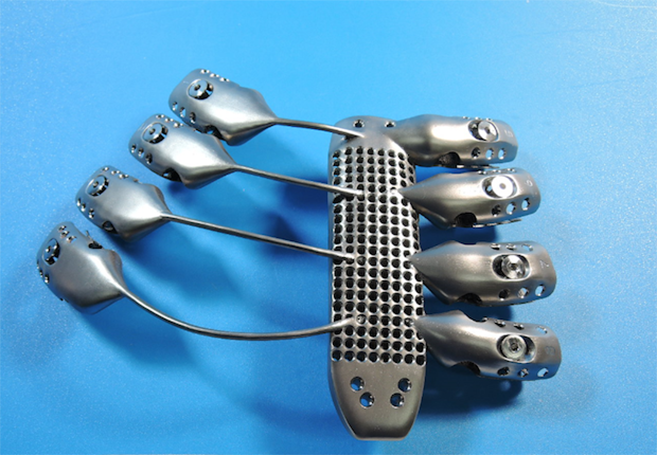In a medical first, a 54-year-old Spanish cancer patient had a large portion of his ribcage and sternum replaced by a customized 3D-printed titanium implant. The company behind the groundbreaking procedure is Melbourne, Australia-based CSIRO. In a September 11th press release from the Australian government, Australian Minister for Industry and Science Ian Macfarlane said, “This breakthrough is an impressive example of what can be achieved when industry and science come together. This collaboration crossed disciplines and international boundaries, with a clear benefit for both this individual patient and for surgical practice.”
After being diagnosed with a chest wall sarcoma, the 54-year-old man’s surgical team made the decision to remove his sternum and a portion of his rib cage and replace it with an implant. The implant was designed and manufactured by medical device company, Anatomics, who utilised the CSIRO’s 3D printing facility, Lab 22. The surgical team, Dr José Aranda, Dr Marcelo Jimene and Dr Gonzalo Varela from Salamanca University Hospital, knew the surgery would be difficult due to the complicated geometries involved in the chest cavity.
“We thought, maybe we could create a new type of implant that we could fully customise to replicate the intricate structures of the sternum and ribs,” Dr Aranda said. “We wanted to provide a safer option for our patient, and improve their recovery post-surgery.” That’s when the surgeons turned to Anatomics. After assessing the complexity of the requirements, Anatomics CEO Andrew Batty said the solution lay in metallic 3D printing.
“We wanted to 3D print the implant from titanium because of its complex geometry and design,” Mr Batty said. “While titanium implants have previously been used in chest surgery, designs have not considered the issues surrounding long term fixation. Flat and plate implants rely on screws for rigid fixation that may come loose over time. This can increase the risk of complications and the possibility of reoperation.” Through high resolution CT data, the Anatomics team was able to create a 3D reconstruction of the chest wall and tumour, allowing the surgeons to plan and accurately define resection margins.
“From this, we were able to design an implant with a rigid sternal core and semi-flexible titanium rods to act as prosthetic ribs attached to the sternum,” Mr Batty said. Working with experts at CSIRO’s 3D printing facility Lab 22, the team then manufactured the implant out of surgical grade titanium alloy. “We built the implant using our $1.3 million Arcam printer,” Alex Kingsbury from CSIRO’s manufacturing team said.
“The printer works by directing an electron beam at a bed of titanium powder in order to melt it. This process is then repeated, building the product up layer-by-layer until you have a complete implant. 3D printing has significant advantages over traditional manufacturing methods, particularly for biomedical applications. As well as being customisable, it also allows for rapid prototyping – which can make a big difference if a patient is waiting for surgery.”
Once the prosthesis was complete it was couriered to Spain and implanted into the patient. “The operation was very successful,” Dr Aranda said. “Thanks to 3D printing technology and a unique resection template, we were able to create a body part that was fully customised and fitted like a glove.”
Minister Macfarlane said this type of collaboration can transform the way industries operate and compete in international markets. “Collaboration is the key to boosting Australia’s innovation performance. Initiatives like our Industry Growth Centres will foster these links and relationships which are critical to future successes like this,” Mr Macfarlane said.
In related news, FORTUNE recently profiled Seattle-based startup, Modumetal — a company that has created a method of growing metal like a tree — and is poised to do for metal what 3D-printing is doing for other materials like plastic. You can read the full story at FORTUNE.com and visit Modumetal.com.


